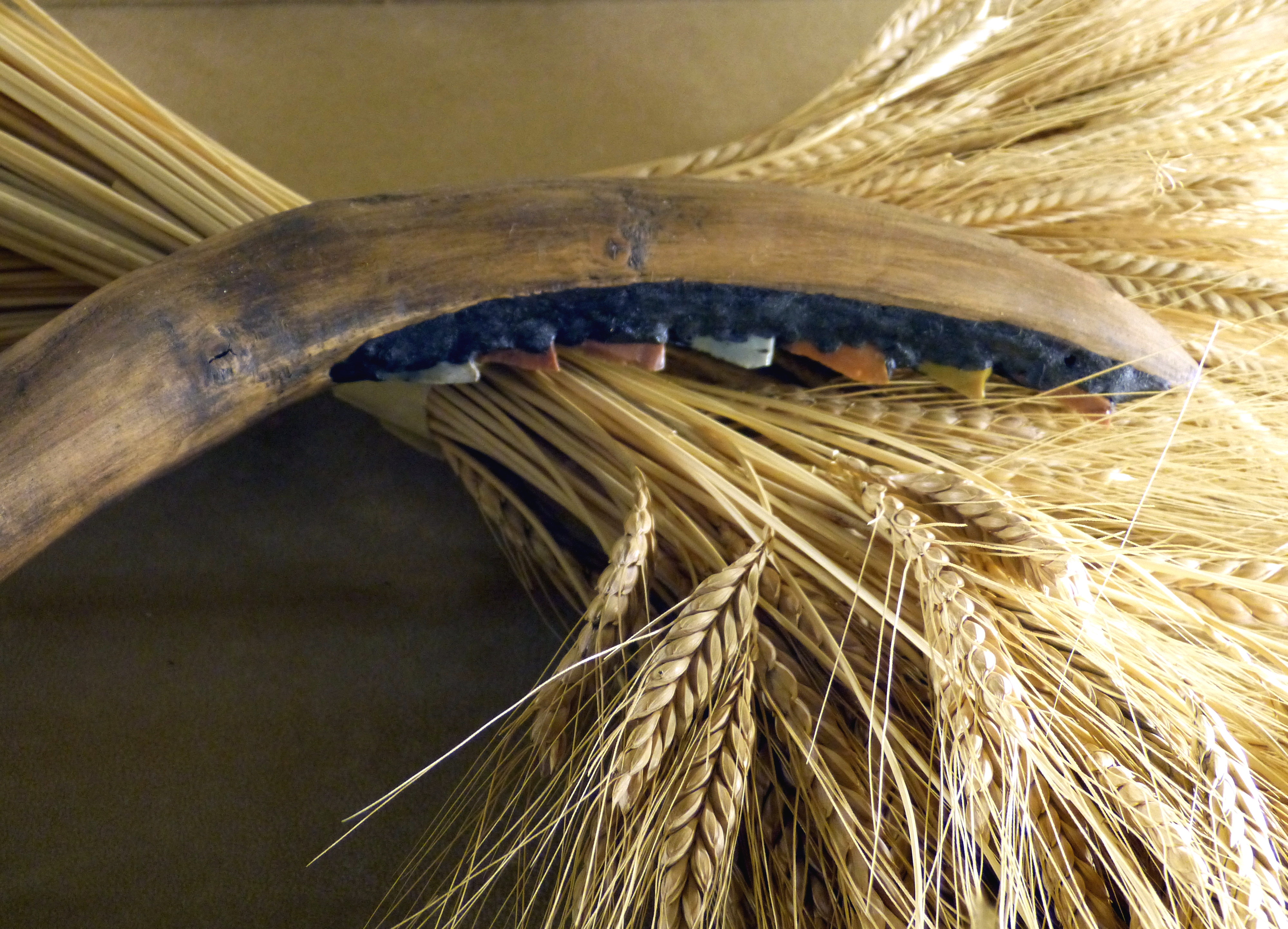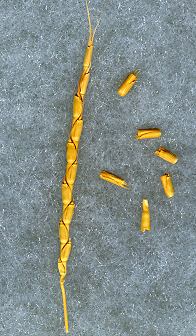|
Wheat
Wheat is a group of wild and crop domestication, domesticated Poaceae, grasses of the genus ''Triticum'' (). They are Agriculture, cultivated for their cereal grains, which are staple foods around the world. Well-known Taxonomy of wheat, wheat species and hybrids include the most widely grown common wheat (''T. aestivum''), spelt, durum, emmer, einkorn, and Khorasan wheat, Khorasan or Kamut. The archaeological record suggests that wheat was first cultivated in the regions of the Fertile Crescent around 9600 BC. Wheat is grown on a larger area of land than any other food crop ( in 2021). World trade in wheat is greater than that of all other crops combined. In 2021, world wheat production was , making it the second most-produced cereal after maize (known as corn in North America and Australia; wheat is often called corn in countries including Britain). Since 1960, world production of wheat and other grain crops has tripled and is expected to grow further through the middle of ... [...More Info...] [...Related Items...] OR: [Wikipedia] [Google] [Baidu] [Amazon] |
Taxonomy Of Wheat
During 10,000 years of cultivation, numerous forms of wheat, many of them hybrids, have developed under a combination of artificial and natural selection. This diversity has led to much confusion in the naming of wheats. Genetic and morphological characteristics of wheat influence its classification; many common and botanical names of wheat are in current use. ''Aegilops'' and ''Triticum'' Similarities and differences The genus '' Triticum'' includes the wild and domesticated species usually thought of as wheat. In the 1950s growing awareness of the genetic similarity of the wild goatgrasses ('' Aegilops'') led botanists such as Bowden to amalgamate ''Aegilops'' and ''Triticum'' as one genus, ''Triticum''. This approach is still followed by some (mainly geneticists), but has not been widely adopted by taxonomists. ''Aegilops'' is morphologically highly distinct from ''Triticum'', with rounded rather than keeled glumes. Hybridisation and polyploidy ''Aegilops'' is i ... [...More Info...] [...Related Items...] OR: [Wikipedia] [Google] [Baidu] [Amazon] |
Durum
Durum wheat (), also called pasta wheat or macaroni wheat (''Triticum durum'' or ''Triticum turgidum'' subsp. ''durum''), is a tetraploid species of wheat. It is the second most cultivated species of wheat after common wheat, although it represents only 5% to 8% of global wheat production. It was developed by artificial selection of the domesticated emmer wheat strains formerly grown in Central Europe and the Near East around 7000 BC, which developed a naked, free-threshing form. Like emmer, durum wheat is awned (with bristles). It is the predominant wheat grown in the Middle East. ''Durum'' in Latin means 'hard', and the species is the hardest of all wheats. This refers to the resistance of the grain to milling, in particular of the starchy endosperm, causing dough made from its flour to be weak or "soft". This makes durum favorable for semolina and pasta and less practical for flour, which requires more work than with hexaploid wheats such as common bread wheats. Despite ... [...More Info...] [...Related Items...] OR: [Wikipedia] [Google] [Baidu] [Amazon] |
Emmer
Emmer is a hybrid species of wheat, producing edible seeds that have been used as food since ancient times. The domesticated types are ''Triticum turgidum'' subsp. ''dicoccum'' and ''T. t. ''conv.'' durum''. The wild plant is called ''T. t.'' subsp. ''dicoccoides''. The seeds have an awned covering, the sharp spikes helping the seeds to become buried in the ground. The principal difference between the wild and the domestic forms is that the ripened seed head of the wild plant shatters and scatters the seed onto the ground, while in the domesticated emmer, the seed head remains intact, thus making it easier for people to harvest the grain. Along with einkorn, emmer was one of the first crops domesticated in the Near East. It was widely cultivated in the ancient world, but is now a relict crop in mountainous regions of Europe and Asia. Emmer is one of the three grains called farro in Italy. Etymology Emmer is first attested in 1908 in English as a loanword from German , ... [...More Info...] [...Related Items...] OR: [Wikipedia] [Google] [Baidu] [Amazon] |
Triticum Durum
Durum wheat (), also called pasta wheat or macaroni wheat (''Triticum durum'' or ''Triticum turgidum'' subsp. ''durum''), is a tetraploid species of wheat. It is the second most cultivated species of wheat after common wheat, although it represents only 5% to 8% of global wheat production. It was developed by artificial selection of the domesticated emmer wheat strains formerly grown in Central Europe and the Near East around 7000 BC, which developed a naked, free-threshing form. Like emmer, durum wheat is awned (with bristles). It is the predominant wheat grown in the Middle East. ''Durum'' in Latin means 'hard', and the species is the hardest of all wheats. This refers to the resistance of the grain to milling, in particular of the starchy endosperm, causing dough made from its flour to be weak or "soft". This makes durum favorable for semolina and pasta and less practical for flour, which requires more work than with hexaploid wheats such as common bread wheats. Despite it ... [...More Info...] [...Related Items...] OR: [Wikipedia] [Google] [Baidu] [Amazon] |
Triticum Ispahanicum
Emmer is a hybrid species of wheat, producing edible seeds that have been used as food since ancient times. The domesticated types are ''Triticum turgidum'' subsp. ''dicoccum'' and ''T. t. ''conv.'' durum''. The wild plant is called ''T. t.'' subsp. ''dicoccoides''. The seeds have an awned covering, the sharp spikes helping the seeds to become buried in the ground. The principal difference between the wild and the domestic forms is that the ripened seed head of the wild plant shatters and scatters the seed onto the ground, while in the domesticated emmer, the seed head remains intact, thus making it easier for people to harvest the grain. Along with einkorn, emmer was one of the first crops domesticated in the Near East. It was widely cultivated in the ancient world, but is now a relict crop in mountainous regions of Europe and Asia. Emmer is one of the three grains called farro in Italy. Etymology Emmer is first attested in 1908 in English as a loanword from German , va ... [...More Info...] [...Related Items...] OR: [Wikipedia] [Google] [Baidu] [Amazon] |
Triticum Compactum
''Triticum compactum'' or club wheat is a species of wheat adapted to low-humidity growing conditions. ''T. compactum'' is similar enough to common wheat (''T. aestivum'') that it is often considered a subspecies, ''T. aestivum compactum''. It can be distinguished by its more compact ear due to shorter rachis segments, giving it its common name. In the United States of America, nearly all ''T. compactum'' is grown in dry areas of the Pacific Northwest. ''T. compactum'' is a hexaploid with 42 chromosomes. ''T. compactum'', like other club wheats, has been selectively bred for its lower protein content. Due to the process of selective breeding ''T. compactum'' has fewer HMW-glutenin genes than other species of wheat. Flour made from ''T. compactum'' is thus better suited for the production of cookies. ''T. compactum'' like other bread wheats have never been observed to grow in the wild.Harold J. E. Peake. March 1939. ''36. The First Cultivation of Wheat''. Man. Vol.39. p. 36. ... [...More Info...] [...Related Items...] OR: [Wikipedia] [Google] [Baidu] [Amazon] |
Triticum Spelta
Spelt (''Triticum spelta''), also known as dinkel wheat is a species of wheat. It is a relict crop, eaten in Central Europe and northern Spain. It is high in protein and may be considered a health food. Spelt was cultivated from the Neolithic period onward. It was a staple food in parts of Europe from the Bronze Age to the Middle Ages. It is used in baking, and is made into bread, pasta, and beer. It is sometimes considered a subspecies of the closely related common wheat (''T. aestivum''), in which case its botanical name is considered to be ''Triticum aestivum'' subsp. ''spelta''. It is a hexaploid, most likely a hybrid of wheat and emmer. Description Spelt is a species of ''Triticum'', a large stout grass similar to bread wheat. Its flowering spike is slenderer than that of bread wheat; when ripe, it bends somewhat from the vertical. The spike is roughly four-edged. The axis of the spike is brittle and divided into segments; it shatters into separate segments when ... [...More Info...] [...Related Items...] OR: [Wikipedia] [Google] [Baidu] [Amazon] |
Cereal
A cereal is a grass cultivated for its edible grain. Cereals are the world's largest crops, and are therefore staple foods. They include rice, wheat, rye, oats, barley, millet, and maize ( Corn). Edible grains from other plant families, such as amaranth, buckwheat and quinoa, are pseudocereals. Most cereals are annuals, producing one crop from each planting, though rice is sometimes grown as a perennial. Winter varieties are hardy enough to be planted in the autumn, becoming dormant in the winter, and harvested in spring or early summer; spring varieties are planted in spring and harvested in late summer. The term cereal is derived from the name of the Roman goddess of grain crops and fertility, Ceres. Cereals were domesticated in the Neolithic around 8,000 years ago. Wheat and barley were domesticated in the Fertile Crescent; rice and some millets were domesticated in East Asia, while sorghum and other millets were domesticated in West Africa. Maize was domesticat ... [...More Info...] [...Related Items...] OR: [Wikipedia] [Google] [Baidu] [Amazon] |




